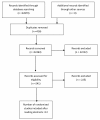Using technology to deliver cancer follow-up: a systematic review
- PMID: 24885758
- PMCID: PMC4101828
- DOI: 10.1186/1471-2407-14-311
Using technology to deliver cancer follow-up: a systematic review
Abstract
Background: People with cancer receive regular structured follow up after initial treatment, usually by a specialist in a cancer centre. Increasing numbers of cancer survivors prompts interest in alternative structured follow-up models. There is worldwide evidence of increasing interest in delivering cancer follow-up using technology. This review sough evidence supporting the use of technology in cancer follow-up from good quality randomised controlled trials.
Method: A search strategy was developed to identify randomised controlled trials and reviews of randomised trials of interventions delivering some aspect of structured cancer follow-up using new technologies. Databases searched were: All EBM Reviews; Embase; Medline (No Revisions); Medline (Non-Indexed Citations), and CAB Abstracts. Included articles were published in English between 2000 and 2014. Key words were generated by the research question. Papers were read independently and appraised using a standardised checklist by two researchers, with differences being resolved by consensus [J Epidemiol Community Health, 52:377-384, 1998]. Information was collected on the purpose, process, results and limitations of each study. All outcomes were considered, but particular attention paid to areas under consideration in the review question.
Results: The search strategy generated 22879 titles. Following removal of duplicates and abstract review 17 full papers pertaining to 13 randomised controlled studies were reviewed. Studies varied in technologies used and the elements of follow-up delivered, length of follow-up, tumour type and numbers participating. Most studies employed only standard telephone follow-up. Most studies involved women with breast cancer and included telephone follow-up. Together the results suggest that interventions comprising technology had not compromised patient satisfaction or safety, as measured by symptoms, health related quality of life or psychological distress. There was insufficient evidence to comment on the cost effectiveness of technological cancer follow-up interventions.
Conclusions: Modern technology could deliver cancer follow-up that is acceptable and safe. More research is required to develop cancer follow-up systems which exploit modern technology, which should be assessed using randomised trials, with consistent outcomes, so that evidence on the acceptability, safety, cost effectiveness and impact in quality of life of technological follow-up can accumulate and be made available to patients, professionals and policy makers.
References
Publication types
MeSH terms
LinkOut - more resources
Full Text Sources
Other Literature Sources
Medical
Molecular Biology Databases


